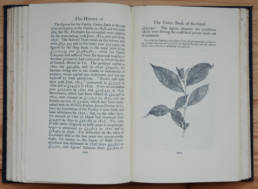Wardian Cases
2012-ongoing
Ongoing series of drawings on the pages of books
Price pegged to the value of the BSE SENSEX
This work is named after a device used for transporting plants in the nineteenth century. Wardian Cases were made of glass and were completely sealed, thereby representing a self-sustaining atmosphere for their botanical contents. They were responsible for the ubiquity of exotic goods in European markets, such as bananas, mangoes, coffee and tea and were also essential tools for both the maintenance of empires and the breaking of monopolies. They were used, for example, to diversify rubber production by shipping rubber plants out of Brazil to parts of the British Empire conducive to their industrial production, thus destroying one monopoly and creating another. A similar manoeuvre – and the one referred to in my work – involved the smuggling of tea plants out of China in the 1840s, when all globally traded tea was produced there, and moving it to British-controlled India, Assam in particular. Tea plants were already growing there, but the technology developed through what was essentially industrial espionage and appropriation led to the mass-production of tea outside China for the first time.
The Wardian Case is named after Nathaniel Bagshaw Ward, a London-based physician and amateur botanist who, in 1829, built the commercial version that was utilised by traders, scientists and colonialists to transport plants around the world. However, it was invented by another amateur botanist, a Glasgow-based advocate called Allan Alexander Maconochie, four years before Ward rolled his version out. Maconochie did not publish or patent his invention, which is ironic given his job was to advise on legal matters, so he did not pursue a claim against Ward. Before the invention of the Wardian case, botanical samples – whether in seed or plant form – were more often than not ruined in transcontinental travel.
Maconochie was not the only Scot implicated in the story of the Wardian case and its use to break the Chinese tea monopoly. A Scottish mercenary, Robert Bruce, who was independently fighting his way through India in the 1820s, seemingly became the first European to encounter the tea bushes of Sadiya, and reported them to his herbalist brother, Charles. Robert died a year later, but Charles established a plantation in Sadiya, producing tea in small batches that were sold through auction houses in London. Subsequently, in the 1840s, another Scot, the Edinburgh-based botanist Robert Fortune, was employed by the East India Company to disguise himself as a merchant and steal a number of tea plants from various regions of China, many of which had not been visited by Europeans before. He successfully transported his botanical loot in Wardian cases to the Assam region, in which Sadiya is located. Here, the East India Company attempted to manufacture the Chinese tea on industrial plantations. These attempts proved largely futile, but the knowledge and the technology that was generated through the endeavour led to a massive expansion of the operations of the plantations established using the native plants.
My work, Wardian Cases, is an ongoing series of drawings of Assam plants, that appear to have been ‘pressed’ into the leaves of books. The subject of the books into which they’ve been ‘inserted’ is that of the British banking industry. Some books are about particular banks, or particular aspects of banking operations (such as the production of banknotes). They are thus a collection of specific knowledges drawn from a general knowledge of the production of ‘value’ within capitalism. The drawings are not intended to be displayed as such, but to exist on the bookshelves of their owners, to exist as some sort of illicit or insidious knowledge. My hope for the objects is that they function simultaneously as a sealed atmosphere and as a modest thing-in-itself that transmits to and infects its surroundings, pointing to ideas of knowledge, movement, value, and power.
I produce these works intermittently as and when I come across an appropriate book, and I sell them through this website. The price of a Wardian Case is pegged to the value of the BSE SENSEX (the Bombay Stock Exchange Sensitive Index). The BSE is the oldest stock exchange in Asia, and grew out of The Native Share and Stock Brokers Association, which was established in 1849 by Premchand Roychand. Roychand was the first listed broker in India who read, wrote and spoke English, a result of his having attended Elphinstone College (now part of the University of Mumbai), which was the first English-language higher education establishment in India. Elphinstone College is named after Montstuart Elphinstone, the Scottish governor of Bombay who established the city’s English-language higher-education system against the wishes of the British government.
The BSE SENSEX is made up of the 30 most important companies listed on the exchange, and is the contemporary bellwether of the Indian economy. It was founded on 1st April 1979, and was assigned a base value of 100 points. The price of a Wardian Case was set at £100 on the 17th December 2012, when the first one was produced, on which day the BSE SENSEX closed at 19,244 points. A Wardian Case bought from me on 17th May 2020, when the value of the BSE SENSEX was 31,097 points, would cost £161.59. The highest price of a Wardian Case since the first one was made was £218 on 14th January 2020.





